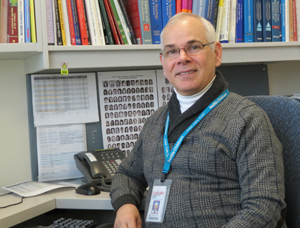 Like many of his patients, Tim Brei, MD, lives with spina bifida, a birth defect of the spinal cord. He understands the challenges facing his patients and their families because he faces them, too.
Like many of his patients, Tim Brei, MD, lives with spina bifida, a birth defect of the spinal cord. He understands the challenges facing his patients and their families because he faces them, too.
After 24 years at the Indiana University School of Medicine, Brei moved west in August 2013 to join the Developmental Pediatrics team at Seattle Children’s Hospital.
“His very presence sends a message to our families,” said Bill Walker, MD, chief of Developmental Pediatrics at Seattle Children’s. “It tells them that a disability does not necessarily have to define or limit you.”
As medical director of the Spina Bifida Association of America, “Dr. Brei is directly connected to the research and resources families need,” added Walker.
A different kind of credibility
Brei says that families and patients know from his gait (or from his crutches or scooter, if he’s using them) that he has a disability. If they don’t ask about it, he usually doesn’t bring it up. Still, he says, “A subliminal message gets through.”
When parents do ask more personal questions, he says they tend to be less about medical care and more about everyday life – was he teased? Was he bullied? Did he have friends?
He answers honestly. And when it’s appropriate, he says, he discourages parents from over-protecting their children.
“Parents know that life is going to be hard for a child with disabilities, so they have a tendency to want to make it as easy as they can,” he said. “It’s a normal instinct, but you have to consciously fight against it if you want to help them become independent.”
Although parents may have heard the same message from others, it has added credibility coming from someone who’s been there, said Brei.
It’s all about independence
Spina bifida occurs during the first few weeks of pregnancy, when something goes wrong with a baby’s developing spinal cord. About 1,500 babies are born with spina bifida in the U.S. every year, making it the nation’s most common birth defect.
Its effects vary widely, depending on which part of the spinal cord and which nerves are affected. Most people with the classic form of spina bifida (called myelomeningocele) have some level of muscle weakness or paralysis in their legs and feet, as well as irreparable damage to the nerves that control the bladder and bowel. About 85 percent to 90 percent of these patients also develop hydrocephalus.
There is no cure for spina bifida, and in 1956 – the year Brei was born – there were also very few treatments. Spina bifida used to be an exclusively pediatric disease, because very few of these patients lived to adulthood. The medical interventions developed during his lifetime have changed the life span and outcomes for people with this disability.
Brei says two kinds of luck were key to him not only surviving, but thriving.
“First, I was very lucky to have a relatively milder biologic effect that did not include hydrocephalus,” he said. “Second, I had the good fortune to have parents who believed that their job was to help me become as independent as possible.”
For instance, he says, he had chores at home – and consequences for slacking off. Sports were out of the question for a child with disabilities in the 1960s, so his parents insisted he take music lessons and join the band, choir and other extracurricular activities. By junior high, he was responsible for his own day-to-day healthcare.
Decades later, Brei’s own research is building evidence to support what his parents knew instinctively. He wants to understand which factors contribute to independence in children with spina bifida and which ones are barriers. The answers will become the foundation for new interventions outside of the clinic.
“Kids learn and develop friendships – and also a belief in their capacity – by taking part in extracurricular activities, like sports or music or drama,” he says. “But even today, most kids with spina bifida are isolated and don’t participate in these types of activities.”
The goal, he says, is to keep kids with spina bifida on the same developmental path as their typically developing peers – and that means having responsibilities around the house and interests outside of it.
A dream to become a doctor
Brie’s dream of becoming a doctor took root in college, at Midland University in Fremont, Neb. – but he tempered it with alternate plans.
“People there supported my dream, but they also pushed the sense of reality that it might not happen – and if it didn’t, that wouldn’t be a disaster.”
After all, he reasoned, “Many people who want to be physicians don’t get into medical school – and the number of physicians with spina bifida or another significant physical disability is pretty small.”
In fact, Brei didn’t get into medical school on his first try so he entered a graduate program in Biology. But dreams are hard to shake, so he tried again the following year and was accepted by the University of Nebraska Medical School. He stayed there for his medical residency, and then completed a fellowship in developmental pediatrics at Cincinnati Children’s Hospital Medical Center.
Resources:
- Seattle Children’s Neurodevelopmental Program
If you’d like to arrange an interview with Dr. Tim Brei, please contact Children’s PR team at 206-987-4500 or [email protected].

